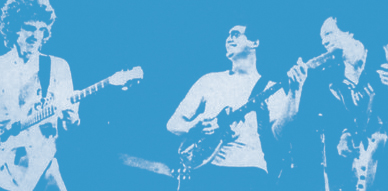
“Even if I had the world between my hands, even if I could make you happy, I don’t know if I could get where you want to be, because you’ve always turned me down.”
I remember long discussions with my friend José many years ago. We were roommates at the time and we were devouring everything the Spanish scene had to offer. We had been exposed to some of it, to the tip of the iceberg, when we were kids back in Lima. Then, when we were living in a tiny studio in Miami Beach, around stray cats, raccoons and possums, we found out a big world to discover. There were amazing sounds coming since the 60s from the Iberian peninsula. But what had happened in South America? Why wasn’t there such a big scene down south as in Spain? And then we turned our eyes (and ears) to Argentina, the other country our teenage years FM radios exposed to us.
What happened in Argentina? We grew up under the sounds of Charly García and his different facets, from his folky Sui Generis, to Seru Giran, to end up in his eclectic solo outings. Soda Stereo were huge, a stadium band. The band leader, Gustavo Cerati, was already releasing solo records and the press was acclaiming him. The third big band from Argentina were the only ones that defined themselves as pop, the underrated Virus. The radio also exposed us to throwaway pop from Los Enanitos Verdes (the green dwarfs) or Los Rancheros, none of them I would recommend listening now unless you have a deep nostalgia crisis. Our curiosity lead us to many other bands like the pop magic of Bristol, to the energetic and fun El Otro Yo, to the obscure Don Cornelio y la Zona, among others. But we noticed that, while in Spain pop was always the way of the underground scene, in Argentina, it was rock. To push a button, the Argentinean main website for their music is called rock.com.ar.
“At what precise moment had Peru fucked itself up?” Mario Vargas Llosa asks in the first line of his “Conversation in the Cathedral” novel. I ask, “At what precise moment Argentinean pop fucked itself up?” Maybe these are strong words, but I can go back and pinpoint the fathers of the Argentinean scene, to Almendra, to look for an answer. Almendra, which means almond, was formed in 1967 when four friends got together: Luis Alberto Spinetta, Edelmiro Molinari, Emilio del Güercio and Rodolfo García. A year later, 1968, they release their first single, Tema de Pototo with the fantastic B side that is El Mundo Entre Las Manos. A great pop bliss that surprises compared to the rock-ish, garagey sounds of these years. The delicate and refined style of Almendra’s was so refreshing! But, what happened to them after this single? Where did all the pop go? You can find a bit of it on some tracks like “Campos Verdes” but it is fair to say that they lost their pop sensibility. They became bigger, I mean, they became HUGE, and they toured a lot. Maybe that was a reason? Maybe, like many 70s bands they were trying some new drugs? I don’t know. What is a fact for sure, is that they became rock and roll, they were all about their difficult and skillful guitar solos, long hairs and celebrity attitude.
And it is at this moment when their music becomes popular. Rock tracks as “Rutas Argentinas” or the Hendrix-like “Color Humano” totally teared down the Argentinean pop scene. Almendra embraced rock, Argentina embraced rock, and that fantastic pop single was found in trash bins. What if Almendra continued the path, the route of their first single? Would Argentina had been a pop country through the eighties and the nineties? Maybe. It is a wild guess. But not a wild guess to say that Almendra fucked up the pop scene back then. After Almendra pop was a rara avis in Maradona’s country.
During the last decades there has been some nice pop bands like Entre Ríos or the aforementioned Bristol, so maybe all is not lost.
::::::::::::::::::::::::::::::::::::::::::::::::::::::::::::::::::::::::::::::::::::::::::::::

